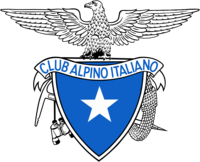
The Brenta Group or Brenta Dolomites is a mountain range, and a subrange of the Rhaetian Alps in the Southern Limestone Alps mountain group. They are located in the Province of Trentino, in northeastern Italy. It is the only dolomitic group west of the Adige River. Therefore, geographically, they have not always been considered a part of the Dolomites mountain ranges. Geologically, however, they definitely are - and therefore sometimes called the "Western Dolomites". As part of the Dolomites, the Brenta Group has been officially recognized as UNESCO World Heritage Site under the World Heritage Convention.

The Alpini are the Italian Army's specialist mountain infantry. Part of the army's infantry corps, the speciality distinguished itself in combat during World War I and World War II. Currently the active Alpini units are organized in two operational brigades, which are subordinate to the Alpine Troops Headquarters. The Alpini's name comes from their inceptive association with the Alps, the mountain range that Italy shares with France, Switzerland, Austria, and Slovenia. An individual soldier of the Alpini is called Alpino.

The Swiss Alpine Club is the largest mountaineering club in Switzerland. It was founded in 1863 in Olten and it is now composed of 110 sections with 174,726 members (2023). These include the Association of British Members of the Swiss Alpine Club.

Adolf respectively Adolfo Kind was a Swiss chemical engineer and one of the fathers of Italian skiing.

The South Tyrol Alpine Club, abbreviated AVS, is an association of German and Ladin-speaking mountain climbers in South Tyrol, northern Italy. Founded in 1946, it is subdivided into 36 sections and 58 local divisions. The AVS is based in Bolzano and has more than 76,000 members.
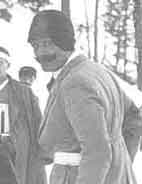
Ottorino Mezzalama was an Italian mountain climber, and is deemed to be one of the two pioneers of Italian ski mountaineering besides Luciano Roiti. He died in an avalanche accident in the Rochemolles Valley. The Ottorino Mezzalama Hut of the Club Alpino Italiano (CAI) below Pollux as well as the famous Mezzalama Trophy competition and the Mezzalama Skyrace were named in honor of him.

Cristina "El Grio" Castagna was an Italian mountaineer and the first Italian woman to climb Makalu. She died in 2009 on Broad Peak, after reaching the summit.

Alpine club huts or simply club huts (Clubhütten) form the majority of the over 1,300 mountain huts in the Alps and are maintained by branches, or sections, of the various Alpine clubs. Although the usual English translation of Hütte is "hut", most of them are substantial buildings designed to accommodate and feed significant numbers of hikers and climbers and to withstand harsh high alpine conditions for decades.
The section of an Alpine club is an independent club or society that, together with the other sections, forms the main organisation. Membership of an Alpine club is normally only possible through membership of a section.
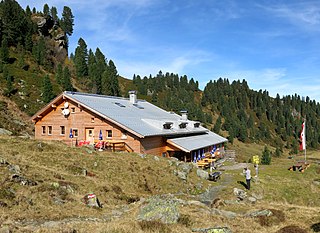
The New Bamberg Hut lies at 1,756 m AMSL in the Kelchsau in the Kitzbühel Alps in Austria and is a mountain hut owned by the German Alpine Club's Bamberg Section.
William Lowell Putnam III was an alpinist, author and retired broadcasting executive. He was Trustee Emeritus of the Lowell Observatory, a private astronomical research facility. He was the son of politician and businessman Roger Putnam and a member of the prominent Lowell family of Massachusetts.

Ohannés Gurekian was an Armenian architect, engineer, and alpinist.

Rifugio Sanremo is a refuge in the Ligurian Alps in Italy. Located at 2,054 m, is the highest mountain hut in Liguria.
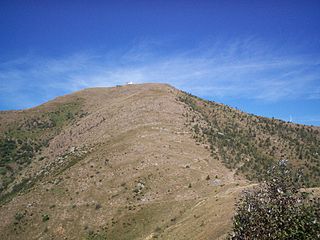
Monte Tobbio is a 1092 metres high mountain of the Apennines, located in the Italian region of Piedmont.

The Società degli Alpinisti Tridentini (SAT) is an alpine club operating in the Italian alpine province of Trento. It is the largest branch of the Italian Alpine Club.

The Antonio Locatelli hut is a mountain refuge located in the Tre Cime Natural Park in Alto Adige-South Tyrol, Italy. It sits at an altitude of 2,450 meters.
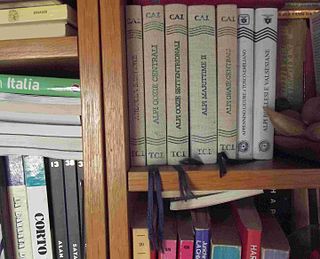
The Guida dei monti d'Italia is a series of guidebooks published in Italy by the Club Alpino Italiano (CAI) along with Touring Club Italiano (TCI) in two periods, the first from 1908 to 1932 and the second from 1934 to 2013.

Mount Gimont is a mountain 2,646 m above sea level in the Montgenèvre Alps, in the Cottian Alps. It is located on the border between Italy and France (Hautes-Alpes).
Stefano Zavka was an Italian mountaineer and alpinist. Zavka's disappearance on K2 received wide exposure as the expedition was documented by Italian journalist Marco Mazzocchi and public broadcaster RAI for the documentary K2: The Dream, the Nightmare.
